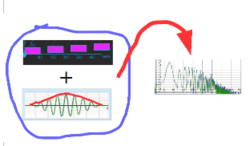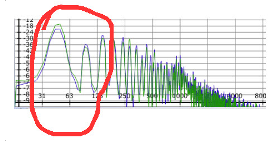In the World of Grains – Part 7

In the World of Grains – Part 7
(contains embedded video – excerpt from my e-book about sonic grains: https://www.dev.rofilm-media.net/node/332) If you want to support my work, please make use of the "PayPal" button - thank you very much indeed!
Here we have to differentiate between at least 2 levels of organisation: the (single) grain level, and the level of clusters of grains (sometimes called “events”, sometimes called “molecules”).
On the level of a single grain there are only three basic parameters:
-
the duration of the grain
-
the overall volume envelope of the grain (“grain window”)
-
the spectral content of the grain and its development during the grain´s lifetime (duration).

The musical meaning of the grain´s duration, it´s lifetime, is obvious, and doesn´t need further explanations. The grain´s duration seems the least problematic aspect. We simply determine the grain´s lifetime in milliseconds. Done!
Done? Well, not really, as there is an interaction between the duration and the spectral content going on. I´m going to talk about it in a second. But otherwise, and as long as we are not interested in the compositional aspects of the grain´s parameters, the number of milliseconds is a sufficient description indeed.
 The musical meaning of the grain´s overall volume envelope is how soft or how harsh the transition between consecutive grains - or between a grain and silence - happens. The grain window, the overall volume envelope, is a bit more complex, but still quite easily manageable. There are a couple of window types out there, and even if we wanted to create a volume envelope of our own, if would “only” need a mathematical equation describing the development of the volume during the grain´s lifetime to characterise our newly invented grain window. Some typical volume envelopes are the square, rounded square, (positive) sine, Hann (a bell-shaped volume envelope), Blackmann (a taller bell-shaped volume envelope) etc.
The musical meaning of the grain´s overall volume envelope is how soft or how harsh the transition between consecutive grains - or between a grain and silence - happens. The grain window, the overall volume envelope, is a bit more complex, but still quite easily manageable. There are a couple of window types out there, and even if we wanted to create a volume envelope of our own, if would “only” need a mathematical equation describing the development of the volume during the grain´s lifetime to characterise our newly invented grain window. Some typical volume envelopes are the square, rounded square, (positive) sine, Hann (a bell-shaped volume envelope), Blackmann (a taller bell-shaped volume envelope) etc.

The real problem begins with the third parameter, the grain´s spectral content. Not enough, that there is an infinite number of different possible spectral contents. But what´s more, there is an interaction going on between the grain´s spectral content and the duration, the lifetime of the grain, as well as with the grain´s overall volume envelope. Changing the duration changes the spectral content quite often. How is that?
Let´s imagine a simple sine wave of 50 Hz. This sine wave repeats its cycle 50 times per second, its wavelength is 1,000 ms divided by 50, what is 20 milliseconds.
With the grain´s duration of remarkably more than 20 ms, there´s no problem to expect. Several cycles of the sine wave fit into a single grain.
But reducing the grain´s lifetime, and approaching the border value of 20 ms, we discover, that the influence of the grain´s volume envelope increases, and additional frequencies occur in the spectrum.
And going even shorter than 20 ms, which means, that not even a single cycle of the sine wave fits in the grain´s duration, changes the spectrum, the sonic content of the grain dramatically. Please watch the linked video demonstration.
Just by the way: In the region slightly above 20 ms (the wavelength of the sine wave) there are a couple of modulation effects going on, e.g. amplitude modulation with the frequency of consecutively repeating grains acting as the modulating frequency. Below 20 ms we generate wave distortion effects.
 And what happens with the sine wave does also happen with the individual lower frequencies of a more complex spectrum, those lower frequencies, which often enough contain the fundamental, the pitch of e.g. an instrumental sound. But this is still the minor problem we have to face with classifying the grain´s spectral content. The main problem remains the mentioned fact of infinite numbers of possible sonic contents. To tell you at once: this matter is still being controversially discussed, and far from being solved in the world of musicology. But Iˇm a big fan of practical approaches. And so I´m going to suggest a very practical solution to the problem in the next article (practical but well-founded nevertheless – and quite complex as I have to admit). My suggested will be based on what you might want to have at hand while composing / producing, and what is audible at all.
And what happens with the sine wave does also happen with the individual lower frequencies of a more complex spectrum, those lower frequencies, which often enough contain the fundamental, the pitch of e.g. an instrumental sound. But this is still the minor problem we have to face with classifying the grain´s spectral content. The main problem remains the mentioned fact of infinite numbers of possible sonic contents. To tell you at once: this matter is still being controversially discussed, and far from being solved in the world of musicology. But Iˇm a big fan of practical approaches. And so I´m going to suggest a very practical solution to the problem in the next article (practical but well-founded nevertheless – and quite complex as I have to admit). My suggested will be based on what you might want to have at hand while composing / producing, and what is audible at all.
to be continued
to part 1: ("A Short History of Granular Synthesis - Part 1"):https://www.dev.rofilm-media.net/node/340
to part 2: ("A Short History of Granular Synthesis - Part 2"): https://www.dev.rofilm-media.net/node/342
to part 3: ("A Short History of Granular Synthesis - Part 3"): https://www.dev.rofilm-media.net/node/346
to part 4: ("A Short History of Granular Synthesis - Part 4"): https://www.dev.rofilm-media.net/node/356
to part 5 ("In the World of Grains - Part 1"): https://www.dev.rofilm-media.net/node/364
to part 6 ("In the World of Grains - Part 2"): https://www.dev.rofilm-media.net/node/373
to part 7 (“In the World of Grains – Part 3”): https://www.dev.rofilm-media.net/node/378
to part 8: (“In the World of Grains – Part 4”): https://www.dev.rofilm-media.net/node/385
to part 9: (“In the World of Grains – Part 5”): https://www.dev.rofilm-media.net/node/390
to part 10: (“In the World of Grains – Part 6”): https://www.dev.rofilm-media.net/node/398
to "In the World of Grains" part 8: https://www.dev.rofilm-media.net/node/414
to "in the World of Grains" part 9: https://www.dev.rofilm-media.net/node/421

Add new comment